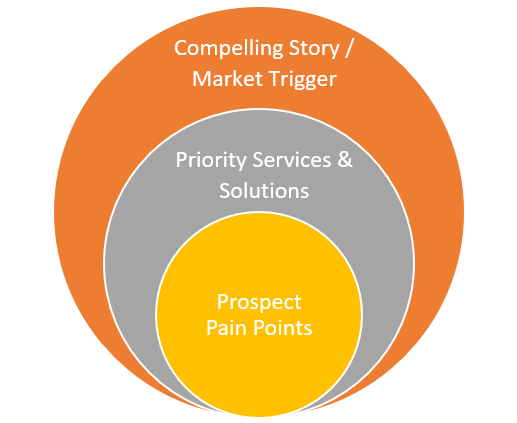From Issues-Based to Audience-Based Content: Aligning Marketing & Sales Around Shared Goals
In theory, Marketing and Sales should work together to enhance brand awareness and reputation, engage new and existing leads and turn prospects into customers. In theory.
In reality, for many B2B companies and in certain industries—financial and professional services being particularly guilty of this—the two departments have traditionally functioned in different realms to varying degrees of success. Where Marketing is seen as the home of customer research, communications, media relations, social media, web development, advertising, and events, and Sales as the home of—well—the sales function, sales support and revenue generating functions of a business, the two often operate with different approaches, if not different objectives and KPIs altogether.
What does that mean for you and your clients?
When Marketing & Sales play well together, the results are what you might expect: a more impactful, more cohesive, more engaging and more successful marketing program that makes better use of content marketing to generate demand and ultimately more revenue.
The Transition from Issues-Based Marketing to Audience-Based Content Marketing
The bread and butter of most Marketing departments is thought leadership and content. As no one reading this article needs to be told, thought leadership can be an incredibly valuable tool for companies to build broad awareness of its expertise, perspective and experience on priority topics that pertain to its key service offerings.
Success for Marketing & Comms departments often translates to KPIs like share of voice, amount and quality of earned media coverage, sentiment, key message penetration, as well as how different content assets are performing in terms of visits or overall engagement, how many new leads are being brought in, positive engagement on social media channels on certain topics, and others.
However, while important for an awareness level program, this issues-based approach—centered around participating in or owning the conversation on a specific topic—doesn’t consider how that awareness will lead directly to sales nearly as much as it should.
That goal—revenue generation—should be the ultimate goal for any marketing or communications professional.
For marketers and communications professionals, the audience should be the most important piece of the puzzle. By shifting to an audience-based approach, you’ll be better able to align with Sales’ objectives and contribute directly to the bottom line.
By centering marketing and communications on priority audiences, you are able to build a more personal and lasting relationship with prospects, better understand their pain points (both as it relates to the services you offer but also the ancillary challenges they face in other aspects of their personal or professional lives that may impact their purchasing decisions), and helps you to lead them through their buyer journey to a potential sale.
Many companies have already made the transition to a more audience-based approach, aided by the rise of data analytics tools that let you better understand and follow your audience, through whichever channels they get their information. For more on how to approach analytics in your marketing and communications programs, read this recent piece by my colleagues, “From Insights to Actions: a PR Pro’s Guide to Analytics.”
The primary result of approaching your communications through the lens of your priority audience? Better storytelling. Better pull-through of key messages centered on your audience, instead of focusing on just one or two of the many topics your audience cares about.
With better storytelling also comes a much more united set of goals between Marketing and Sales, with the customer at the center and increased revenue the destination.
Creating an Audience-Based Content Marketing Program That Drives Revenue Growth
Step one of creating a good audience-based content marketing program is to determine what you should focus on as the central them of the program.
Start first with the priority audience pain points, then figure out how your services or solutions solve those pain points. Lastly, but importantly, overlay the compelling story or market trigger that will help keep your audience connected as they engage with your brand over time.
Digging into the three components further:

- Priority Services & Solutions: What do you/what does your client want to sell? What is going to bring in revenue? What is the ultimate goal? Without unlimited resources, what service should you focus on? Whether you are a matrixed organization with hundreds of potential services or a focused business with four key offerings, getting specific about what your business objectives are is important.
- Prospect Pain Points: Is there a market need for your priority service? This sounds simple, but think about it: Regardless of what you are trying to sell, if there is no clear market need, it might not be the best candidate for a campaign. Remember: The number one reason businesses fail is lack of market need.[1]
- Compelling Story or Market Trigger: This is a key component and the ingredient most often left out of the equation. In addition to identifying the priority service and the prospect need, are you able to actually tell a compelling story about this service? Are you able to start a prospect at the beginning of their buyer journey convince them, through relevant, timely, compelling storytelling to move toward becoming a paying customer? With the amount of content that each individual consumes each day or each week, telling a cohesive story with each of your content pieces will go a long way in keeping them engaged.
If you have all of these things, you probably have a good candidate for an audience-based content marketing campaign.
As you plan out your campaign, keep in mind the key questions you need to be answering at each stage of the buyer journey.
Awareness Stage: This is where the prospect will be identifying the issue at hand, understanding what the problem is and what the benefits are of finding a solution.
Questions to answer:
- Why should I change what I’m doing now?
- What triggers will force me to address the issue?
- What are my peers doing?
Consideration Stage: This is where you should be offering high-level ideas on how to solve the problem and, if possible, beginning to introduce what your/your client’s approach to solving the problem would be.
Questions to answer:
- How do I solve for the issue?
- What specific service or solution do I need?
- How will I benefit from taking this approach?
Decision Stage: This is where you deliver the unique differentiators versus competitors, why the prospect should act now, and the specific expected ROI they can expect with working with you/your client.
Questions to answer:
- Why should I invest in this service/solution now?
- Who has the best expertise to support me?
- What’s the ROI?
Think about your audience throughout the marketing and sales process. Do your content pieces make sense as a whole series as you deliver them to your prospect over time? Will they understand why they are receiving the second piece of content as follow-up to the first? Do they tell an ongoing and cohesive story that encourages them to explore the next step of the sales journey?
Consumers today—whether individual buyers or business buyers—receive more content and touchpoints from businesses than ever before. By aligning your communications efforts to the audience as they learn, engage and discover your brand and your services instead of centered on a single topic, you’re able to tell a more comprehensive and appealing story, make a better connection with your/your client’s brand, gain more opportunities to market effectively to them and yes—lead to better revenue generation directly from marketing and communications.
As you think through your organization’s marketing approach—or that of your clients—consider how an audience-based approach might better align the goals of Marketing and Sales and benefit all parties involved.
[1] https://www.cbinsights.com/research/startup-failure-reasons-top/
Miles Hill is a Vice President in the Professional Services practice of The Bliss Group. Interested in learning more about aligning marketing and sales goals? Reach out to Miles at mhill@theblissgrp.com.
This article was originally featured in O’Dwyer’s August 2021 Financial and Professional Services Magazine (view original PDF).
